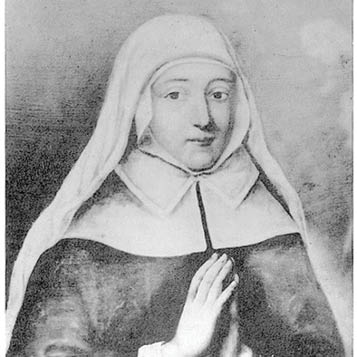The Influence of Louise Hours on John Baptist de La Salle and the Institute
One of the many women who influenced John Baptist de La Salle and the work of the Institute, Louise Hours was born in Le Touvet, about 30 km north-east of Grenoble, in 1646. Her mother, Isabeau Pelu was a domestic in the château of the Count de Ferrières, and her father, Benoît, was his gamekeeper. Still in the Count’s service, the family moved to the foot of Parménie in 1648, in the parish of Beaucroissant. It was there that Louise grew up, looking after the sheep on the Parménie properties.
In the early 1670s Louise felt called to restore the ruined chapel on Mount Parménie, and sought the approval of several people, including Claude Canel, a canon of Saint-André in Grenoble. Canel, and (later bishop) Jean Yse de Saléon (1669-1751), were both involved in arranging for the Brothers to come to Grenoble. It was Yse de Saléon who invited a convalescing De La Salle to visit Parménie, where he was then in charge of what had become a place of retreat.
Louise gathered an informal community of young women, ‘Domestic Sisters of the Parménie Retreat House’ who lived a life of prayer and attended to the Parménie retreatants. Bernard Hours, author of the Founder’s critical biography (2019), notes that the last of these sisters died in 1755.
Hours explores two proposed scenarios for the Founder’s stay at Parménie, where Louise was caring for retreatants in the complex she had helped to restore. One view is that John Baptist visited the retreat house twice, at the end of winter and again for nearly all the spring of 1714. The other is that he was there only for about two weeks from the end of March to early April. Hours finds no conclusive evidence to support one over the other.
As an historian, Hours is also unable to confirm some of the conventional understandings of the encounter between Louise Hours and John Baptist de La Salle. Nonetheless, he notes that the memoirs of the Brothers must have borne witness to its significance, so he can affirm that ‘the importance of meeting Louise Hours is certainly not an invention of the first biographers’.
Whether this insightful woman encouraged De La Salle to resume his leadership of the Brothers before, or after, he received the letter from the senior Brothers in 1714 is not really important.
It seems clear that what she did was to encourage him, in the peaceful and beautiful place she had helped to restore, prayerfully to discern God’s loving will. As Bernard Hours points out, despite their very different backgrounds and projects,
[b]oth were committed to following the will of God despite the adversity this exposed them to. Both of them had founded projects that could potentially move in directions they would not be able to control, and both Louise’s little community and that of the Brothers had an ambiguous status [that is, neither had canonical or legal approval].
Louise died in 1727. She is buried in the crypt of the chapel at Parménie, as is Brother Leo Burkhard (1922-2007), who devoted himself to research about, and to the contemporary restoration of Parménie.
John Cantwell, fsc
- Log in to post comments

